| content | about | pitch | subscribe | find | advertise | mouthoff |
|
primagallerina's oralreport only collect: our secret agent goes digging for five artists' hidden treasures |
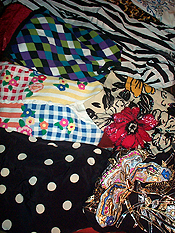 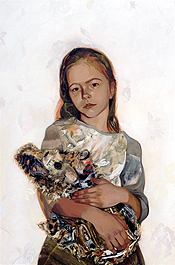 Ava, acrylic, collage, oil on canvas, 36x24 in., 2003. Courtesy Carl Hammer Gallery. |
marylouzelazny Artist's statement: I have been exhibiting mixed-media and collage paintings and drawings for more than 20 years. Tell us about your collection. I collect unusual fashions, ensembles, costumes, formalwear, and any other hideous, embarrassing outfits that are the flotsam of thrift stores, garage sales, and hand-me-downs. I'm especially drawn toward sweaters with appliqué, gaudy beadwork, and embroidery, usually worn in honor of a holiday. I refer to these as "happy sweaters." What's the most significant object in your collection? It's really hard to pick one item; they all have their uses. My Norma Kamali black-and-white striped jumpsuit is a crowd-pleaser. The pale red, fringed pantsuit is fascinating; the African dashiki matched set, and the light-blue leather 1950s' coat with white fur trim, were thrills to find. The black sweater with the gold-and-silver butterfly can stop traffic. What sustains your interest in these clothes? I spend some of my daydreaming time thinking of just the right Halloween costumes for my friends. I dress many of my models in the classes I teach at the School of the Art Institute. I also use some pieces as elements in my paintings. The most important aspect is the vernacular of pattern and fashion. It is curiously ignored by some, or elevated by others. I've observed that most people are oblivious or choose to block out the various textiles that might cross them in a day. There's often a good reason to ignore them--most items are very ugly, tasteless, kitschy, or too personal. Fashions and textiles are "read," and discarded or remembered, based on such varied criteria. Is the quest for new items as important as--or perhaps more important than--their eventual discovery? I prefer to find rather than to look. If I've had a run of unsuccessful outings, I will abstain for a time. How far will you go to acquire objects for your collection? Normally I refuse to go east of Western Avenue. The choices for my collecting niche are abundant, so I really don't have to go very far or exert much effort. The effort involved is in selection, not in discovery. When I do travel out of town, something has to be very convenient for me to be motivated. Do you display and/or organize your collection, and if so, how? I keep things in boxes and drawers and use them as needed. Do you see any connection between the objects you collect and the artwork you make? Yes: in both there is a multiplicity of visual stimuli. Do you collect more when you're in between making works of art, or when you're in the middle of creating them? I'm a firm believer in shopping ESP. I have in my mind's eye the "look" of a fabric, and I'll have a strong impulse to visit one of my favorite stores. This impulse can happen to me any time, although I often need something for a project or model. Is there a connection between the search for the collectable object and its eventual acquisition, and the process of making a work and its final product? It's much easier and faster to purchase a collectable object. That easiness is a hopeful moment, carrying within it the serendipity of the creative process. Mary Lou Zelazny is an adjunct associate professor at the School of the Art Institute and is represented in Chicago by Carl Hammer Gallery. |
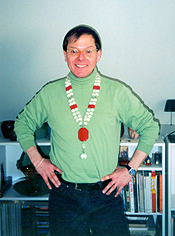  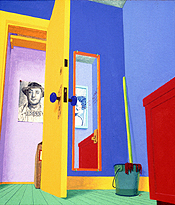 Mop and Bucket, gouache, 3-1/2x3 in., 2004. Courtesy the artist. |
nicholassistler Artist's statement: In tiny, brightly colored images, I create an imaginary "inner reality." Traveling from this world to another, as though through a keyhole, the viewer is pulled into a metaphysical realm of fantasy, and invited to leave behind external limitations. What do you collect? Actually, I'm not actively collecting anymore, because my priorities for how I want to spend my time have changed. But I've collected lots of different things over the years. Some collections have gone by the wayside a long time ago, but one I still have is my collection of bakelite jewelry. What's bakelite, exactly? It's phenolic resin. It was the first thermo-setting plastic--which means it can't be made liquid again--and was invented by Dr. Leo Baekeland sometime between 1900 and 1910. Initially, it was used as an insulator, but it became particularly popular for jewelry and household items from the late 1920s up through the very early 1940s. When did you start the collection? In the early 1970s. How many pieces do you own? I would guess about a thousand. What attracted you to bakelite? I was very interested in Art Deco, Art Moderne stuff; bakelite was a modern material for that time, so you find a lot of pieces in that style. I like the texture, the feel of it. Also, most of it is hand-carved, and something about that appealed to me. What was your most significant find? There are many, but probably the weirdest one was this totally over-the-top necklace. Actually, my partner Sam's mom found it in, like, nowhere Southwestern Ohio. It's 1920s in style, with clear and frosted beads and these big hunks of red bakelite. It was beyond anything I'd ever seen before, and I've never seen anything like it since. Have you ever worn it out of the house? No...or I should say, not yet! What sustained your interest in collecting bakelite? Well, there's an incredible variety of color. But probably more than anything else, I was attracted to the whimsical nature of it. They were constantly whipping up new designs--some were geometric and abstract, while others were made to look like animals, people, or objects. The variety seemed really infinite. To this day, I will come across designs I've never seen before. Was the quest for new objects as important as--or perhaps more important than--their eventual discovery? The quest was always an adventure of sorts. In the early 1980s, I'd go to the Kane County flea market knowing I'd come away with a bag of stuff. Finding it was always exciting; initially, there'd be a little adrenaline rush in discovering something I'd never seen before. But even more exciting was the ride home, when I was really able to examine things; I could look in my bag and see, "What loot did I get?" That was a great moment. As I look back on it, though, I think of it as being pretty obsessive-compulsive. How did Sam feel about your fixation? He was OK with it. It wasn't like I was unable to feed us because of it! How far have you gone to acquire objects for your collection? I can't remember anything specific. When I was actively collecting, I used to think that if I didn't buy it, it couldn't exist! But I'm just grateful to see things now; I don't have to own everything anymore. Although there's one particular kind of bakelite that I would still be willing to pay for, and probably more than what I would normally. It's referred to as Alexandrite. It's translucent, and depending on how light hits it, it shifts color. How do you display your collection? I have a display case I got from the White Elephant shop back in 1986, and I use it as a headboard. It has three rows of bracelets hanging on rods, and then the bottom shelf is pretty much paved with pins and clips and other bracelets. Do you see any connection between the objects you collect and the art you make? The color and the whimsy have had a definite influence on my art. Also, that capacity for limitless inventiveness, within the constraints of a small scale, is something I consistently strive for in my work. Did you collect more when you were in between bodies of work, or when you were in the midst of trying to create new work? For me, it was much more of a distraction from making work. I would use the search as a time-filler, because I was avoiding dealing with the studio. It was a procrastination tool. Is there a connection between the search for the object and its eventual acquisition, and the process of making work and its final product? I think so. When I search for this thing and then finally find it, something about that echoes the process of working in the studio--that "ta-da!" moment when I'm done. There's another similarity, too, in that I don't see my work as something I make, as much as something I discover. I work intuitively, and my ego isn't caught up in it. It's really about the thing and less about me. In retrospect, I think collecting and owning possessions had a lot to do with insecurity about who I was. These days, I'm more secure, and it doesn't matter. So now, they're my retirement fund! Nicholas Sistler is represented by Printworks, Chicago; Hunsaker/Schlesinger Fine Art, Santa Monica; and Miller/Block Gallery, Boston. He will have a solo exhibition at Printworks in September 2004. |
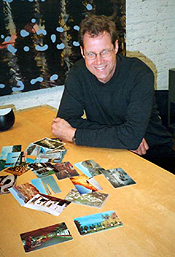 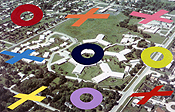 Postcard Series: Comparing Theories, oil and inkjet on canvas/wood, 28x44 in., 2003. Courtesy the artist. |
timothyvanlaar Artist's statement: My recent paintings are based on found photographs that are scanned, enlarged, and printed on large inkjet printers, then over-painted with patterns and various coded material. What do you collect? It seems I collect collections; I've done it all my life. I collect postcards, pottery, rocks, fossils, shells, and various strange organic things--nothing horribly eccentric. I also collect modern and Arts-and-Crafts furniture, hammered copper, tiles, first-edition American fiction, mountain-climbing literature, and Japanese novels in translation. And I have a huge collection of blues CDs. Tell us about your postcards. They started out as souvenirs from my travels when I was a boy, which evolved into an interest in postcards themselves. They didn't have to be souvenirs of my experience, but objects that were interesting for their own sake and for the sake of a collection. There's an interesting distinction between souvenirs and collections that Susan Stewart writes about in her book On Longing--souvenirs operate in connection to the past and are almost by definition objects of nostalgia, while collections are more future-oriented because they're usually unfinished--you're always thinking about the next thing you can add to them. Also, as a group of objects--and this is what I'm really interested in--a collection has the possibility of indefinite reverie. Postcards are strange hybrids; they're clearly paradigmatic souvenirs. If you're collecting other people's souvenirs, they're not really your personal souvenirs. Then again, anything you collect is a souvenir of the moment you found it. What sustains your interest in collecting? Well, interests in classification and taxonomy and completeness all indicate some desire to control things, so I suspect that's a motive. I'm not sure I like that, but it's probably there. Collecting is also full of little paradoxes and contradictions. When you're collecting similar things, you're most aware of difference. Also, there's this desire to understand an object at the same time you're decontextualizing it, so it's no longer understood within its usual use. But some people are just more taken with collecting as a kind of ritualized obsession--and I can have an almost unhealthy compulsion to collect things. Maybe I just really like stuff. I wonder if there's some greedy, hungry aspect of collecting--a kind of restless discontent--because you never have enough things. I used to collect wishbones, which is sort of a dumb thing to collect. So if you notice one day that you've been collecting wine corks, you might wonder if you have a problem! Do you collect wine corks? Let's just say I nipped that one in the bud. I was saving all the caps off my paint tubes for a while--I don't know why. I had a huge quantity of them, and they all had a different color inside. That's a whole other kind of collecting behavior: a hoarding instinct. I'm fascinated with people's trashy collections, not just the socially acceptable ones. I knew a guy who saved apple cores, but I don't know if that counts as a legitimate collection or just plain obsessive-compulsive behavior. I'm not sure where the line between those two impulses lies. Do you see any connection between the objects you collect and the artwork you make? Actually, I used to make images of my collections; about 15 years ago, I was interested in still life, and I was fascinated with 18th-century engravings and lithographs of botanical, zoological, and ethnographic collections. It was a time when people were trying to classify everything, and they used those prints--as artists use art--to represent the world. Now I'm using things in my collections to make images, like the postcards. I'm particularly interested in the ones I call "scenic disappointments." Why do you call them that? Well, a postcard is usually a paradigmatic image of something, so the ones that don't have that kind of status in relationship to a place are, in a way, failures. Using postcards can so easily fall into categories of nostalgia or kitsch or pop culture. I think these sort of pathetic images resist that more, and because of this you can make something with them. They give you room to work; they don't constrain you like a clichéd scene. Heroic scenery of a city or of the mountains is almost impossible to do anything with. Is there an element of nurture in collecting "failures"--like rooting for the underdog? I don't know if I'm nurturing them, exactly, but I do think they encourage a kind of sympathy. There's also an amused wonder about them. Why would somebody make an image like this? Why would anyone buy an image like this, and send it to somebody else? They make you question what's considered significant, and the status of more acceptable images. It's possible they have a position not unlike Outsider art, or the modernist interest in primitivism, because there's something naive, or something we assume to be innocent, about them. Do you collect more when you're in between making works of art, or when you're in the middle of creating them? I collect all the time. And I can start a new collection at any moment; there was one point when I just felt compelled to collect different colored sandstone pebbles. Is there a connection between the search for the collectable object and its eventual acquisition, and the process of making a work and its final product? Well, one of the things that keeps you going as an artist is that you have to make the work in order to know what it's going to be. And similarly, making a collection is a fairly creative thing; it's an intellectual and imaginative activity, in that you're visualizing this collection all the time and trying to bring it into existence. That process, like artmaking, is full of surprises. A lot of collections also have to do with knowledge. Of course, the decisions we make when collecting are influenced by all sorts of beliefs and prejudices, and filtered through what we already know. But I think collecting--like painting--is a way of knowing and representing the world. Timothy van Laar is a professor of painting at the University of Illinois at Urbana-Champaign. He lives and works in Chicago. |
  Untitled, collage with hand-painted papers, 31-1/4x23-1/2 in., 2001. Courtesy Zolla/Lieberman Gallery. |
andrewyoung Artist's statement: My artmaking tries to span the breadth of human experience--somewhere between awareness of our physical, mortal, and terrestrial selves and everything we aspire to through our academics, religion, philosophies, and writing. What do you collect? Ancient coins, American coins and currency, stamps, tintype photographs, 1930s' cigarette cards, vintage postcards and photographs, Islamic prayer-book pages, South Asian textiles, Russian icons, pre-Columbian South American dolls, prehistoric arrowheads and spear points, seashells, rocks, minerals, fossils, 19th-century engravings of plant parts and shells, old-fashioned games that require some kind of pure or direct manual skill, marbles, small boxes and containers, vintage family photos, peculiar texts, artwork, pottery, statues, art books, and natural history references. Then there's a file I call "Amazing Things," which are paradoxical and thought-provoking items I've clipped from magazines or recorded. My family and friends also send me things, and every year we have a run-off when we rate them as "somewhat amazing," "particularly amazing," or "beyond amazing," and then choose the winner. How long have you been collecting? Ever since I was a kid. We lived on the East Coast, and I love the ocean. So I would be the one who spent most of any family outing with my arms and legs--and head--in a tidal pool. They would find me in the seaweed, pulling things out and sorting them. Maybe collecting starts with this sensitivity and/or weird ability to spend a long period of time looking at something. Later on, I was a working biologist for three years, so I also have a disposition toward organization. But the impetus to amass or collect or sort is never-ending. Someday, I'll probably have to move out of town simply to have space to put things. What draws you to these things? Everything has a story attached--it has been discovered, investigated, researched, excavated, or uncovered by me, personally. In some cases, there's a sentimental attachment--it may have been my grandfather's, or been given to me by a special person. There are running themes that have to do with natural history, and then artifacts that seem to evidence a very basic humanity that represents physical proximity to our being-ness and our connection to the natural. Fundamentally, I think that's the draw for me. Maybe the sorting, the organization, the categorization, the reframing, and the contextualization are part of that longing for an association or connection to the world. Many of your collections come from your travels. Do you collect things from where you happen to be, or do you travel to seek out a particular object? I would say the former. My father was in the Foreign Service, and early in our lives he took us to Europe to live in Switzerland. He also had this sensibility about collecting from his travels. Through various fellowships, exhibitions, and teaching opportunities, I've been able to travel to Ecuador three times, and to Pakistan, and I would always tack on a day or two to explore what those places were about--the mechanisms behind their identity. So the collections are very much a consequence of what I've been able to access. What's the most extreme thing you've done to obtain something for your collection? Once, I was searching for fossils by a river in northern California; they were embedded in a sandstone wall that was dissolving and quickly turning to mud. I decided that to get to some of the better locations, I should rappel off the top of this 80-foot-high cliff using not ropes, but the available roots of a coastal redwood tree. And roots are not as reliable as one might imagine. So I'm hanging by a root while holding a hammer, calling below for people to catch these fossils because I didn't have a spare hand in which to nest them. Clearly, there was a stupidity element that was completely superseded by my determination to find the most exquisite scallop fossils. That was a little bit crazy...but I was in my 20s. Do you see any connection between the objects you collect and the artwork you make? My collections don't ever physically find their way into the studio--I think it would be a strange kind of mimicry to draw straight from the objects. But the spirit of my most recent works has everything to do with what is gained, and lost, by the event of collecting. What is it that compels us--or me, specifically--to collect and sort, if not to find ourselves in some kind of relationship to our surroundings, and therefore be more stable and secure in that experience? Also, the attitude toward collecting in those works is like that of the Renaissance artists; when they added birds and botanicals to their encyclopedias, those elements were always more beautiful in the catalogue than they were in real life--they were somehow idealized. So the very act of collecting or representing almost suggests the loss of the thing in its real state. The artwork--like the way I contemplate the things I own or possess temporarily--becomes a surrogate for something, and the experience I once had with it. Is there a connection between the search for the collectable object and its eventual acquisition, and the process of making a work and its final product? Yes. I read this story about Brancusi; when a dealer or a museum would take something on loan from his studio, it would create a vacancy in the unconscious arrangement of objects in his sanctuary. So he would make a surrogate of that object--a copy--to take its place, and keep that experience of his artistic development intact. I've never quite overcome the subtle grieving when work leaves the studio--there's a small impulse to recover these familiar friends that were the art objects. Similarly, with collections, there's this unconscious arrangement and rearrangement to make the experiences they represent available, and when objects are missing or put away, there's a psychological experience of disruption. It's not a materialistic attachment, but a memory issue--remembering everything I've come near in my life, and everything with which I've had some kind of intimate experience. That's what collecting is--it's the way to find that intimacy again and again. Andrew Young is represented by Zolla/Lieberman, Chicago; Littlejohn Contemporary, New York; Bentley Gallery, Scottsdale, Arizona; and Ann Reid Gallery, Ketchum, Idaho. |
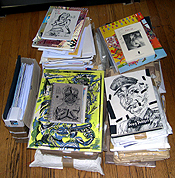 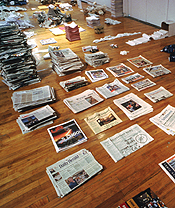 Paper Trails (Going Through Your Garbage), installation at Gallery 400, Chicago, 2002. Courtesy the artist. |
marcfischer Tell us a bit about the scope and scale of your collections. The most evolved collection I have is a series of files containing maybe 4,000 photos cut from books, magazines, and newspapers. I've been casually clipping photos for about the past 13 years. When enough photos accumulate around a particular theme, I start a new file. At this point there are about 100 different categories like "Enlargement," "Copies and Originals," "Transparency," "Suspended and Hanging Bodies," "Schematic Faces," and "Scars." These files contain aspects of the visual world in a way that cuts across normal divisions. Art can mix with documentation from medicine; news photos can mingle with children's book illustrations or porn. These files are like a laboratory where pictures can be rearranged to form new relationships and ideas. Manipulating simple objects or photos is a fast way of re-imagining the world on a small and safe scale before trying out more complicated ideas on a larger scale. I also have a lot of paper ephemera and printed material: religious tracts, street flyers, 'zines, books, decorative drawings made on envelopes mailed to me by people in prison, and artists' books and printed matter. Books, records, leaflets, and other objects designed to be cheaply produced and widely circulated to large and diverse audiences are particularly inspiring to me; they help me formulate ideas about how creative work can go out into the world. I'm part of a group, Temporary Services, that makes a lot of booklets, and I make a lot on my own. We often exchange our publications with others who self-publish, so I tend to develop small archives of friends' publications. I also enjoy exchanges with a French artist, Bruno Richard, who's sort of a cult figure in the world of underground publishing, and a highly energetic maker of wildly perverse and inventive drawings. I've never met him in person, but over the past five years or so, he has sent me thousands of pages of copied drawings, ephemera from his life, books, photos, and writings. How long have you been collecting things? Always. When I was young I avidly collected baseball cards, even though I never cared very much about sports. I think I was more interested in being able to endlessly sort lots of small pictures, and I enjoyed the variations between different photos of the same players across time, or photos of the same person in different design frameworks in cards made by different companies. Now, I view my collections as just another aspect of my creative work as a whole--which also includes writing, doing work on my own and in collaboration with others, creating exhibitions, and self-publishing. I don't make distinctions about which parts of this are art and which aren't. I don't care--it's all continuous to me. Is there some underlying theme to the objects that intrigue you, or particular aspects of life/the world you're trying to document? What makes collections of any type of object interesting or useful are the kinds of relationships and insights one can glean from seeing similar--or dissimilar--objects juxtaposed in thoughtful ways and provided with a meaningful context. When objects are presented with a coherent context and visual structure, it becomes possible to see and learn things that might not be discernable otherwise. One example of this would be a collection I have of found bookmarks. These are mostly things that weren't originally intended to be used as bookmarks, but that I've found stuffed in library books--scrap paper, shopping receipts, Post-it notes, index cards, ticket stubs, nail files, and other bits of crap. Lumped together in a box, they look like a pile of ordinary trash. When presented together with care in neater arrangements and thematic divisions, it becomes possible to survey a common human activity. You can appreciate these little improvisations and behavior patterns--perhaps someone first stopped at the library, then bought some potato chips at the Walgreens a block away, and on the way home began reading the book on the train and used the Walgreens receipt as a bookmark. So this collection is an informal record of an aspect of life that is probably common in any culture that has books. I also just revisited a wonderful collection in the Mütter Museum in Philadelphia; they have hundreds of neatly sorted objects that a doctor saved after he removed them from peoples' throats. You can imagine all of these little emergencies spanning many years--people getting metal toy jacks and nails and safety pins and buttons stuck in their windpipes. It's fun to see that there are dozens of safety pins--mostly open--as though everyone is, at some point, destined to swallow one of those things. It's like a massive archive of stupid things people put in their mouth or couldn't be bothered to chew more carefully. Do you incorporate your collections into your work, and if so, for what purpose? I began directly incorporating my collections into my art about 10 years ago. Most recently, I participated in a project Dan S. Wang and Mike Wolf organize at Mess Hall called Selections, which invites people to curate an evening of recorded music. Drawing from my record collection, I surveyed more than 40 years of "Screaming in Music." My selections crossed genres and included Wilson Pickett, Napalm Death, Diamanda Galas, Brainbombs, and Deep Purple. The intent was in part to focus the audiences' ears on just one aspect of the music, the screamed vocals--which in some songs are just a small part of the music, and in others are the dominant part of almost the entire song. Sometimes I make temporary collections for an exhibition, which are dissolved after I'm finished with the work. For a recent project at Gallery 400, Paper Trails (Going Through Your Garbage), I collaborated with University of Illinois at Chicago's recycling program, which dumped about 1,000 pounds of the school's paper waste into the gallery. I attempted to sort it all into thematic and aesthetic categories, forming about a hundred different arrangements. These collections surveyed the varieties of paper waste generated by the population of a university, while also poking at issues of social responsibility and ethics--which are always tied to art but infrequently acknowledged in an open way. At the end of the show, the gallery staff swept everything back into a big pile and the recycling department re-sorted the exhibit according to their own categories. One of the things you've been collecting is correspondence from your friend Angelo, who is an artist and is currently incarcerated. How did that start? I've known Angelo entirely through written correspondence since around 1991. His cellmate at the time had requested a copy of a fanzine I used to publish, and seeing my interest in art and prison issues, he encouraged Angelo to write me and send one of the historical narrative drawings he makes. I was extremely compelled by the ballpoint pen drawing he sent; it showed all the prison narratives of power and domination displaced to an historical scene of Roman soldiers torturing their Christian captives. Angelo makes tons of fascinating and really unsettling drawings. This mailing was the start of our ongoing dialogue. It soon became clear that I was about the only friend Angelo had on the outside. His drawings and writings kept getting stolen by guards and other prisoners, so he began sending them to me for safe-keeping. Mostly, I just store everything in the envelopes it's sent in. If Angelo gets out I could return them to him--nothing has been sold. In the meantime, I've collaborated with Angelo, and Temporary Services has presented his drawings and collaborated with him on a book and exhibit about the myriad things prisoners invent. I would like to find more ways for people to see the full scope of Angelo's work in the future, but it's hard to find interesting and sensitive placements for his art and writings. When good opportunities arise, I coordinate his participation. What's it like to be the caretaker for all this stuff? In the case of Bruno Richard and particularly Angelo, it is strange to be a caretaker for so much material that hardly anyone ever gets to see. Their work calls up hard moral questions and can be exhausting to look at in large quantities. These two archives represent a daunting amount of thought and energy. They need to be seen by more people. Which of your collections do you personally find most compelling, fascinating, or strange? I have a collection of about 30 prison love letters that are continually sent to me by Angelo's former cellmate Paul, whom I also correspond with. Paul is evidently tall, toned, and has long blond hair. He has many amorous admirers who shower him with unwanted attention and very graphic love notes. He doesn't want to keep them--not surprising, given how creepy they are--so he sends them to me. Most of them are very aggressive and quite disturbing; I'm not sure I've read any of them more than once. Due to widespread illiteracy in the prison system, some of the letters are in one person's handwriting but sent by different authors. Do you ever envision a life without your archives? If I lost everything, I'm sure I'd eventually get over it and survive just fine. I've probably almost exhausted my enthusiasm for some of my collections. One thing that interests me about Angelo is that before prison, he had many collections--comic books, silent movies, etc. Now he's in a place where he can't accumulate too much stuff, or it'll be confiscated. So instead, he makes lists of things, like his favorite movies and books he has read in prison, and archives his own art production by making written records of what he has done. His written lists seem like a stand-in for physical collections. Personally, I don't see much value in hoarding things only for your own gratification without making an effort to share them with others, or to share the insights you might be able to gain from spending so much time with your own archives. People who collect things should also hook up with people who have similar interests and help them out. The difficult thing about having collections is to find ways of sharing this material that are thoughtful, instructive, interesting, and creative. Marc Fischer is an artist and a member of the group Temporary Services. He is also part of Mess Hall, an experimental cultural space in Rogers Park. |